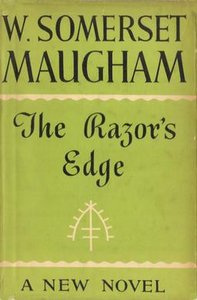I read a lot of Somerset Maugham novels when I was in my twenties. One of them was ‘The Razors Edge. I recall somebody – probably my devoutly Roman Catholic Aunt Chrissie – saying it was on the Vaticans list of proscribed books which, naturally, was a huge incentive for me to get a copy. Another novel was The Moon and Sixpence, which Philip Thody, our French professor at Leeds University, referred to in a lecture, inspiring me to read it.
I have just reread these two novels back to back. Both are easy and enjoyable reads. Somerset Maugham seems to have gone out of fashion, but he is an excellent His style can be a tad pedestrian and repetitive at times, but he has a flair for and dialogue and for creating memorable scenes and characters.
‘The Moon and Sixpence is dominated by Charles Strickland and ‘The Razors Edge by Larry Darrell. There is another memorable character in the latter – Elliott Templeton – but he is not half so interesting as the enigmatic Larry. Elliott is the ultimate socialite, a man who lives for parties, whereas Larry is the exact opposite – a recluse
The two novels feature protagonists who are outside the mainstream of society – unconventional men driven by a burning passion. Larry cares nothing for money or work traumatized by the death of his friend in WW1, he dedicates his life to finding spiritual truth. Charles Strickland, another outsider, has no interest in anything except painting. His artistic genius is not discovered until after his death, but poverty and obscurity do not worry him; as long as he is painting, pursuing his dream of artistic perfection, he is happy. When these two nonconformists talk to ordinary mortals, the conversation is often strained and hilarious because of the huge differences between them.
The title of each novel is cryptic. There is no mention of a moon or a sixpence in the novel of that name, so the reader is left guessing. Defeated, I consulted Wikipedia, which gives an explanation. The same applies to ‘The Razors Edge; there is no such phrase anywhere in the book, so once again Wikipedia came to the rescue. Maugham based his title on a verse from Indian scripture: The sharp edge of a
razor is difficult to pass over; thus the wise say the path to Salvation is hard. This refers to Larrys spiritual quest.
‘The Moon and Sixpence was published in 1919, and ‘The Razors Edge in 1944. I find the latter more artistically satisfying. As the Times Literary Supplement says on the back cover of my paperback edition: Immensely ... a fascinating book. It is 100 pages longer, more ambitious in its characterizations (two main characters instead of one), and it features Somerset Maugham writing in the first person. He could easily have invented a first person persona, but he doesnt; the I is the author on and participating in the action. Most unusual. I cannot think of another novel where this is the case.
Actually, there is little to choose between these novels; each has its strengths and weaknesses. ‘The Moon and Sixpence has some great scenes when the action is in Paris, but it flags towards the end in Tahiti. ‘The Razors alive whenever Larry appears, except for at the end when he spouts a great deal of information about his time in India, which I found tedious. And the final paragraph
of ‘The Razors Edge is rather lame, with Maugham desperately seeking a way to unify the disparate characters: For all the persons with whom I have been concerned got what they wanted we the public in our heart of hearts all like a success story; so perhaps my ending is not so unsatisfactory after all.
As I said before, Maughams prose is variable – sometimes but occasionally crisp and poetic. My favourite quotation from ‘The Razors Edge is when Larry tells Isabel of his desire to loaf and then, out of the blue, startles her (and the reader) with the words: The dead look so terribly dead when theyre dead.
Now I am looking for a Maugham novel I have never read.









